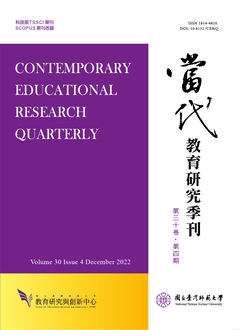

正值青少年階段的國中生,社會面轉向同儕,成功地建立友誼成為青少年重要的任務之一,而觀點取替是影響友誼成功與否的重要因素。因此,本研究乃將研究目的放在探討國中階段同班同學之間友誼的觀點取替特性,參考Selman觀點取替發展的研究;Selman主要以兩難故事為研究設計,從受訪者的回答中分析觀點取替的能力。本研究則以班級為範圍,從國中生生活世界的友誼狀態、實際行動與感受中,探究國中生觀點取替之特性;研究方法為個別深度訪談、文件分析及非參與觀察法,研究對象係來自臺北某市立國中一個班級的16名學生,各8位男生、8位女生及其導師一位,追蹤三年以瞭解其特性。<p>
研究發現,影響友誼面向觀點取替發展的互動類型,以雙方觀點之差異,從小到大,分別為友誼關係中的「入境探俗」與「友誼內衝擊」,以及友誼關係之外的「友誼外衝擊」。國中生觀點取替之發展成熟度不一,但整體而言,是在逐步深入瞭解他人內在的同時,亦逐漸將觀點的重心從自己轉向他人的歷程。國中生可發展至「井蛙窺象式」之觀點取替,這是一種只從自己背景經驗詮釋對方性格,但僅是片段擷取卻擴大詮釋的觀點取替特性。在此特性及友誼需求交互作用下,好友之間的緊密度很強,但個性強烈的國中生面對觀點差異較大的同學時,則可能會出現排擠行動。
Friendship is very significant for junior high school students in adolescence. Building friendship is an important task for them. Perspective taking is an important ability of making friends. The research purpose was the salience of perspective taking in friendship of junior high school students. Selman's levels of perspective taking is the milestone of perspective taking research which investigates subjects' answers of a dilemma story. The research approach focused on the real lives of friendship of junior high school students in a class and explored their experience.<p>
The research methods were individual in-depth interview, document analysis and non-participative observation. Subjects were 16 students of a class and their homeroom teacher. This was a follow-up in junior high school from Grade 7 to 9.<p>
The research found that interactions which affected the development of perspective taking in friendship domain were: the distance between two perspectives from near to far, "exploring culture as entering friends' inner world," "friendship shock with friends" and "friendship shock without friends." Junior high school students' perspective taking abilities vary. As a whole, it developed by deeper translating others as well as shifting focus of perspective from self to others.
Some students could develop the perspective taking as "a well's frog watching an elephant." Students with this perspective taking interpret others by their own personality and experience and expanding the interpretation at well. In that case, friends were strongly close; however, radical students may bully others out of perspectives differences.

本著作係採用創用 CC 姓名標示-非商業性 3.0 台灣 授權條款授權.
本刊國立台灣師範大學教育研究與創新中心
106台北市和平東路一段162號 | 電話: 02-7749-3670 | E-mail: cerecerq@gmail.com
教創中心 | 師大 | 電子報 | 線上投審系統
本刊由國家科學及技術委員會人文社會科學研究中心補助經費
© 2014 CERI-NTNU
